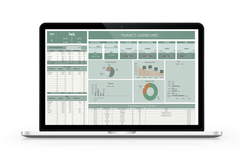You don’t need to be a financial expert to invest wisely—just a clear idea of what you're aiming for. Setting investment goals isn’t about chasing the biggest returns or timing the market. It’s about creating a plan that fits your timeline, your lifestyle, and your version of success.
Without a goal, investing is like setting off on a journey with no destination. Sure, you might end up somewhere interesting, but probably not where you actually wanted to go.
Here’s why goal setting is essential to building a successful investment strategy:
1. Direction and Purpose
A solid investment goal gives your money a mission. It helps you understand why you're investing and how to get there. Without that clarity, it’s easy to drift, panic, or make decisions based on short-term noise.
Example: If your goal is to buy a house in five years, your investment strategy will look very different from someone saving for retirement in thirty. Your timeline, risk tolerance, and asset choices will all align with your end goal.
RELATED: Set Clear Financial Goals: Your Roadmap to Success

2. Measurable Progress
Goals turn abstract numbers into something tangible. You can see how far you’ve come, spot when you're off track, and make adjustments with purpose—not panic.
Example: Let’s say you're aiming to save £20,000 for a car in three years. Since this is a relatively short-term goal, you’ll likely want to keep your investments low-risk—think high-interest savings accounts, money market funds, or short-duration bonds. The goal isn’t huge growth; it’s safety and predictability.
Now contrast that with saving for retirement in 30 years. With a much longer timeline, you can afford to take on more risk for potentially higher returns—like investing in a diversified stock portfolio. Different goals, different paths.
Try our Free Online Savings Distribution Tracker
3. Motivation and Discipline
Investing isn’t always thrilling. In fact, on most days, it’s about as exciting as watching paint dry—on a spreadsheet. But that’s where having clear goals comes in handy. They give you a reason to keep going when you’d rather not, and a sense of purpose that sticks around long after the initial enthusiasm has worn off. Especially now, when every other YouTuber seems to be buying property in Portugal or launching a candle brand, it’s easy to feel like you’re falling behind.
A clear goal helps you deal with that feeling. It brings your focus back to your plan, not someone else’s highlight reel. And when the markets wobble or your willpower does the same, it’s your goals—not their beach house—that keep you grounded.
4. Risk Management
Different goals have different risk profiles. Short-term goals generally require safer, less volatile investments, while long-term goals can afford higher risk for greater potential returns.
Example: For a short-term goal like a vacation fund, you might prefer low-risk investments like bonds or high-yield savings accounts. For long-term retirement savings, you might opt for stocks, which are riskier but offer higher growth potential.
Next read: : Understanding Your Risk Profile: A No-Nonsense Guide to Investing Without a Panic Attack
Best Savings Accounts (UK, August 2025): Why You Need One

5. Strategic Allocation
Once you’ve got your financial goals in place, it’s time to match them with the right investment mix. This is where asset allocation comes in—the balance of stocks, bonds, cash, and maybe a cautious toe dipped into something trendier.
Your allocation should reflect not just your personality, but your plan. Are you investing for a new home in five years? Or building long-term wealth to eventually leave the 9–5 behind (perhaps for a more flexible freelance life, or to finally launch that niche podcast you’re convinced has legs)?
Example: If you’re aiming to retire in 20 years, you might lean into equities for growth. But if you're saving to go part-time while running a growing online business or content channel, your allocation might need to be more flexible—blending safety with liquidity to support uneven income and changing goals.
The rise of creators, freelancers, and self-employed professionals means financial planning isn’t as linear as it used to be. Your portfolio needs to reflect that—supporting both future dreams and present unpredictability.
Next Read: : A Beginner’s Guide to Asset Allocation: How to Build a Balanced Portfolio
Conclusion
Use your list of goals and desires as your timeline, and think of your risk tolerance as the compass guiding your decisions. The better you match your investments to those two factors, the smoother your financial journey will be. And when you finally hit those milestones—buying that house, starting your own business, retiring early—you can proudly plant your ownership flag and say, “Yep, I earned this.”
Because financial freedom isn’t just a dream—it’s your destination. Let’s chart the course and start walking.





